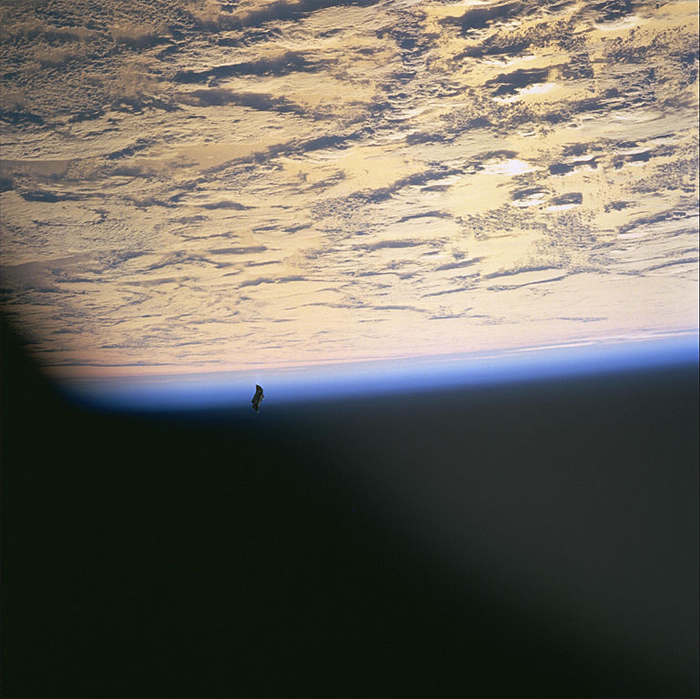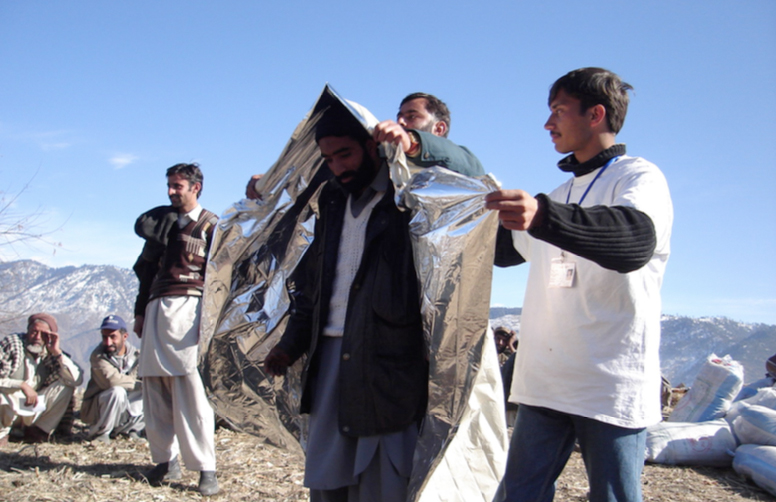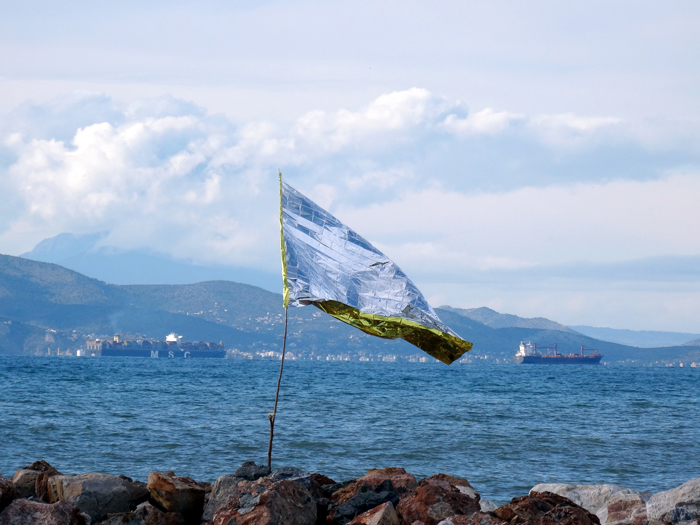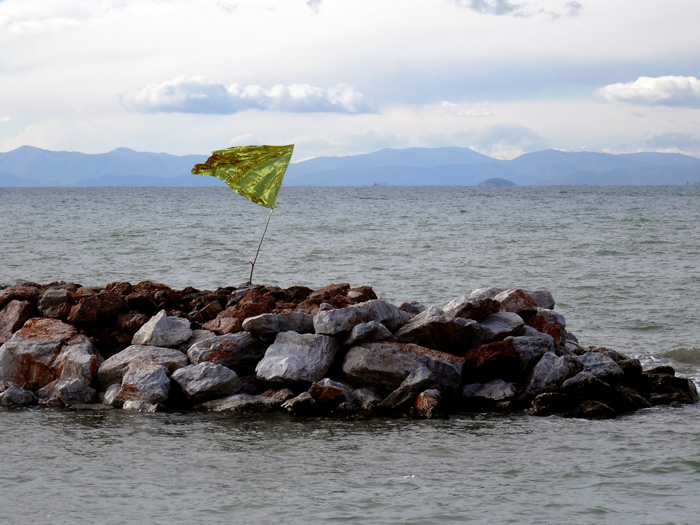On May 14 1973, Skylab, the United States’ first space station, lifted off from Pad A at Kennedy Space Center, atop a modified Saturn V rocket. As it launched into the atmosphere, the uncrewed station suffered severe damage, with its micrometeorite/sun shield shearing off and smashing through one of its two solar panels. Once positioned in orbit, it was only able to open one of the panels, and rapidly began to overheat, threatening to melt plastic insulation and release poisonous gases, rendering the station uninhabitable.
After ten days of emergency training, the crew of Skylab 2 launched on May 25th. On arrival at the stricken space station, astronaut Paul Weitz performed a stand-up EVA from the airlock of their craft – an updated Apollo Command Module – tugging on the jammed solar panel with a hooked ten foot pole in an attempt to free it, while his colleague Joseph Kerwin held onto his legs. The attempt failed. They then attempted to board the space station, which required no less than nine docking attempts and another EVA to disassemble the docking probe.
The crew of SL-2 had brought with them a hastily assembled parasol, designed by renowned NASA engineer “Mr. Fix It” Jack Kinzler, and manufactured by National Metallizing of Cranbury, New Jersey. Once aboard the main station, they opened the small scientific airlock, and unravelled the sun shade: a thin gold blanket which was to remain tethered over the body of the craft for the rest of its service life. Its deployment saved the mission.

National Metallizing was a long-term NASA partner, having been producing reflective materials and other equipment since the start of the space programme. The Skylab parasol was one of a family of such products, originally designed by NASA for the Echo II project: a 40 metre diameter balloon constructed from polyester film coated with aluminium foil. Similar materials, gold and silver in colour and highly reflective, were subsequently used for heat and radiation shielding on the Apollo Missions, the Hubble Telescope, and generations of Mars landers.
It was one such insulation blanket which astronaut Jerry Ross was carrying when he climbed out of Space Shuttle Endeavour in December 1998, on a mission to install the Unity module on the International Space Station. The blanket was designed to cover the trunnion pins which had held the module in the shuttle’s cargo bay during launch. As Ross made his way around the craft, his commander Robert Cabana radioed him to tell him that one of the tethered blankets had got away from him. By the time he turned, it had floated out of reach.
The blanket was large enough to be tracked by the US space surveillance network, which monitors all orbital objects including junk and debris, and was given the international designator 1998-067C. Before re-entering, it was photographed from the Space Shuttle, and several images exist of it in the NASA archives, free-floating some two hundred and fifty miles above the Earth’s surface. These evocative images have been endlessly recirculated on the internet as evidence of a mysterious, alien satellite, known as the Black Knight, which conspiracy theorists claim to be 13,000 years old.

It was a former National Metallizing employee, a keen runner called David Deigan, who was the first person to seriously commercialise NASA’s insulation technology. After completing the New York marathon of 1978, Deigan was handed what he recognised as a “space blanket”, a packet of folded silver sheeting which the Association of International Marathons and Road Races had purchased as an experiment, to keep runners warm between finishing the race and collecting their clothes. Recognising the branding potential of the product, Deigan refined the design and went on to found a company called Heatsheets, which produced higher-quality blankets printed with sponsor’s logos. It grew to become the largest supplier of thermal blankets to marathons worldwide.
In October 2005, an earthquake measuring 7.6 on the Richter scale devastated parts of Pakistan, Afghanistan, and northern India. The aftershocks, measuring up to 6.2, lasted for over a week. More than 79,000 people died, 135,000 were injured, and some 400,000 homes were destroyed, leading to a huge humanitarian and refugee crisis. In response to an online fundraising campaign, Heatsheets produced 150,000 emergency blankets which doubled as ground covers and structural insulation.
In 2011, the BBC reported from COP Margah, described as the most attacked Coalition base in Afghanistan. An American soldier described how the Taliban insurgents were covering themselves with space blankets as they moved around under cover of darkness, to shield themselves from the US military’s thermal cameras. In 2013, artist Ruben Pater released the Drone Survival Guide, an identification poster for military drones, printed in English and Pashto on silver, reflective paper.

Europe and its neighbours are currently experiencing the largest refugee crisis since the Second World War, a displacement of some sixty million people and rising every day. Despite the promises made in October 2013, after the shipwrecks of Lampedusa, and despite the groundswell of horror in September 2015 at the drowning of three-year-old Syrian child Alan Kurdi, the situation at Europe’s borders and on its oceans is getting worse, not better. The first casualty of this year came on the 2nd of January, when a two-year-old toddler drowned off the coast of Lesbos. In all, it is estimated that 3,771 migrants died in the Mediterranean in 2015, an increase from 3,270 in 2014. These deaths are avoidable, unnecessary, and obscene: they are a direct result of the refusal of European nations to open their borders, to act with compassion and humanity, and to accept the reality of the contemporary situation.
When those fortunate enough to survive the crossing reach shore, they are given, if they are even more lucky, a sheet of gold and silver foil. If you visit the beaches of Lesbos and Chios, the Greek islands closest to the Turkish coast, you will find it littered with space blankets, which glitter among the discarded life jackets and deflated rubber boats. They are worn as rain ponchos on the long trudging marches to the registration camps, and used to paper over the rents in shoddy, second-hand tents, pathetically unsuitable to the winter weather.
This is the moment at which our ideas of technology as a series of waymarks on the universal march of human progress falter and fall apart. A single technology – the vacuum-deposition of metal vapour onto a thin film substrate – makes its consecutive and multiple appearances at times of stress and trial: at the dawn of the space age, in orbit and on other planets, at the scene of athletic feats of endurance, in defence and offence in the mountains of the Hindu Kush, on the beaches of the European archipelago. These are moments of hope as well as failure; moments when, properly utilised, technological progress enables us to achieve something which was beyond our capabilities before. And yet: we are still pulling bodies from the water wrapped in material which was meant to send us into space.

In Kim Stanley Robinson’s Mars Trilogy, which tells the story of the first colony on the red planet and everything that follows from it, the philosopher-engineer Arkady Bogdanov argues that humanity’s behaviour on the new land should not be limited by the constraints of the Old World.
“I say only this!” Arkady said, staring at her bug-eyed: “We have come to Mars for good. We are going to make not only our homes and our food, but also our water and the very air we breathe — all on a planet that has none of these things. We can do this because we have technology to manipulate matter right down to the molecular level. This is an extraordinary ability, think of it! And yet some of us here can accept transforming the entire physical reality of this planet, without doing a single thing to change our selves, or the way we live. To be twenty-first century scientists on Mars, in fact, but at the same time living within nineteenth century social systems, based on seventeenth century ideologies. It’s absurd, it’s crazy, it’s — it’s —” he seized his head in his hands, tugged at his hair, roared “It’s unscientific! And so I say that among all the many things we transform on Mars, ourselves and our social reality should be among them. We must terraform not only Mars, but ourselves.”
Technologies are stories we tell ourselves – often unconsciously – about who we are and what we are capable of. By analysing their traces we may divine the progress they are capable of assisting, but they are not in and of themselves future-producing, magical, or separate from human agency. They are a guide and a hope. The reality of these technologies and the place of their deployment shows us plainly that another world is not only possible, but coming into being, should we choose to recognise and participate in it. Technology alone will not achieve such change, merely reflect back our failure to capitalise upon it. Its proper use is not as a bandage for the present, but as a banner for the future.

Flag for No Nations: temporary installation at Ellinikon, Greece, James Bridle, January 2016. Documentation at Flickr.
Image Credits: NASA image archive and Mercy Corps. Much use was made of the NASA Spinoff Magazine article Reflecting on Space Benefits: A Shining Example and James Oberg’s lecture STS-88 and Black Knight.
Comments are closed. Feel free to email if you have something to say, or leave a trackback from your own site.